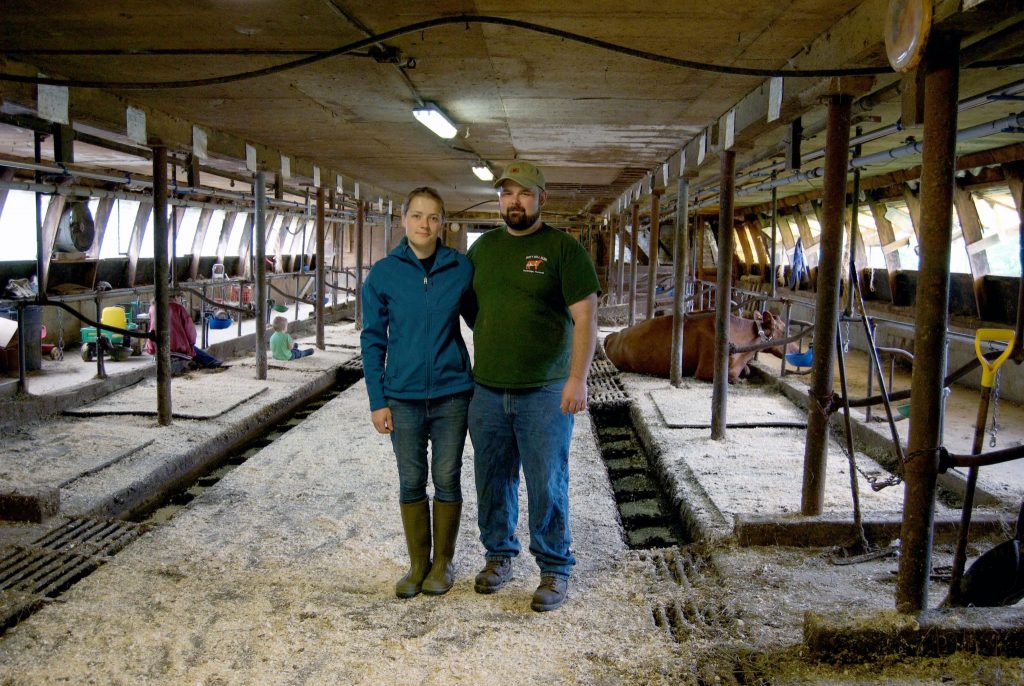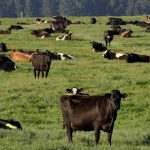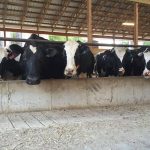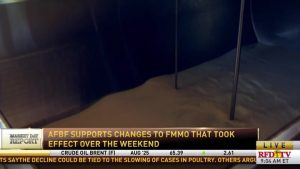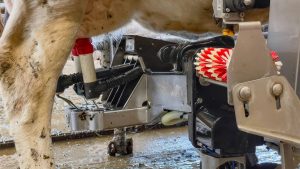
TUNBRIDGE — On the first Friday of July, Amber Hoyt stood in the dairy barn she owns with her husband, Scott. She held a plastic ziplock bag with small, mangled pieces of stainless steel wire in her hand.
Since December, the Hoyts have pulled the wire from the bodies of three cows that recently died after showing symptoms the farmers hadn’t seen before: sudden bloody noses, a high number of aborted calves, obvious signs of discomfort, a decline in milk production.
Last fall, the Hoyts found the wire scattered throughout the cows’ feed, which they grew on their land and other fields they rent in the rolling hills of Tunbridge. As the weather cooled and the Hoyts transitioned the cows out of pasture, they began feeding the animals silage, which they make by layering chopped hay from several different fields in a bunker.
“We started finding a piece [of wire] here and there,” Amber said. “Then it turned into multiple pieces a day. That’s when we started reaching out to people.”
The wire, they say, is what’s known as lashing wire: a thin, stainless steel strand used in telecommunications projects. As efforts ramp up to expand broadband internet across the state, the wire is wrapped around groups of cables, functioning like a collection of zip ties to stabilize lines from one telephone pole to the next.
The Hoyts began finding coils of lashing wire in locations around the farm. ECFiber, a communication district that serves the Upper Valley, had recently hired Brookfield-based Eustis Cable Enterprises for a project to expand broadband in Tunbridge, and Eustis had employed a subcontractor to install the lines that run through the Hoyts’ fields.
The Hoyts believe the subcontractor left behind the spools in the field, and when the farmers mowed to harvest the feed, the self-propelled chopper plowed through the wire, cutting it into pieces and mixing it in.
In effect, according to the Hoyts’ telling, that created a collection of needles — hundreds, possibly thousands — in 500 tons of hay.

Seeking relief
Hoyt Hill Farmstead, a small, certified organic dairy, includes about 60 milking cows and another 70 heifers. And they eat a lot of hay: in the winter, each cow can consume up to 100 pounds a day.
According to the Hoyts, replacing the 500 tons has presented both a logistical and financial challenge. The feed has to meet requirements for organic certification, and weather conditions have caused prices to surge. And it’s been difficult to dispose of the contaminated hay, which isn’t considered compost and was rejected by waste companies. It still sits fenced off on the Hoyts’ land.
Andrew Bauer, director of operations for Eustis, said the company has paid for three loads of feed for the Hoyts totaling 146 bales, which the Hoyts said they brought in from a feed company in Canada. The Hoyts have had to purchase another eight loads, and now owe more than $40,000 to the Canadian company.
Although a Eustis investigation confirmed that the Hoyts found lashing wire in their feed, Bauer said the company hasn’t confirmed that the cows have been affected specifically by Eustis’ project.
Bauer said it’s possible Eustis and the subcontractor, Crammer O’Connor’s Fiber Genesis LLC, may not be responsible for harm to the Hoyt’s cows.
“Whether they find additional materials, additional companies involved with this, I don’t know,” he said.
Lashing wire is housed in a machine, Bauer said, and the operator will occasionally change out the wire. It could have fallen out while being transported or fallen into some snow, he said.
But Donna McCann, a paralegal with the law firm Cullenberg & Tensen who is working on the Hoyts’ case, said she’s confident the wire is from the broadband installation carried out by ECFiber, Eustis and Fiber Genesis.
“There was nothing else going on there,” she said.
The Hoyts, seeking additional relief, filed a claim with Fiber Genesis in October, which is being processed by insurers for both Fiber Genesis and Eustis.
Fiber Genesis, formerly based in Albany, New York, is no longer in business. VTDigger could not reach representatives from the former business for comment.
ECFiber’s board chair, F. X. Flinn, said the district has a limited role to play while insurance companies review the claim. The district learned of the situation in late May, alerted its lawyer and insurance company, and met with Eustis, he said.
Beyond that, ECFiber is “not privy to any of the details,” Flinn said.
Bauer said Eustis may provide more support in the future.
“The feed that was provided was not something that was done because of an insurance company or anything else,” he said. “That was because we recognize that they’re dairy farmers, and they needed some immediate action. So I would just go as far to say that I’m sure if there was a need, that we would give consideration and see what we could do to assist.”
McCann said she’s now working with the third adjuster from Fiber Genesis’ insurance company. The Hoyts may consider legal action in the future.
When the Hoyts filed the claim, they hadn’t lost any animals. Now three cows have died, and they’ve found wire in each necropsy. They’ve located wire in both their first and second cuts of hay, and believe as many as 70 cows have been exposed.
The “kicker,” Scott said, is that the wire was recently found in a deceased cow named Wally, who had only been exposed to third-cut hay.
“So it must have been in third cut, too,” he said. They’ve considered tilling and replanting all 105.5 contaminated acres, but that’s a costly endeavor they currently can’t afford.
Hardware disease
Like most dairy farmers, the Hoyts have taken preventative measures to protect their cows from ingesting metal hardware, an ailment known as “hardware disease.”
Their chopper, operated by a custom feed producer from Washington, Vermont, is equipped with a magnet that shuts the vehicle off entirely when it detects metal. But stainless steel isn’t magnetic, and it passed through the chopper undetected.
Hardware drops into the cow’s reticulum, at the front of a cow’s four-chambered stomach, near the esophagus, Stuwe said.
The cows also are made to swallow magnets, which sit harmlessly at the bottom of their stomachs and keep accidentally ingested metal — such as chopped fencing wire — from causing internal problems.
“But the bummer here is, it’s stainless steel wire,” said Tom Stuwe, the Hoyts’ veterinarian. In this case, the magnets are useless.
On that Friday in July, Amber and Scott stood in their dairy barn in front of a stall where a cow had died a week earlier. That cow had birthed a stillborn calf on a Tuesday and died the following Saturday.
“She started coming to milk, and all of a sudden she just stopped eating and went downhill,” Scott said. “She died in her stall there.”
Another cow, Iva, stopped eating on Thanksgiving Day.
“She was this huge cow,” Scott said. “Everybody knew her when they came to the barn. She was the one that we took to the fair and all that kind of stuff. She would eat anything you put in front of her, and then she wouldn’t eat grain, wheat, hay — and then she just went downhill from there.”
They lost another, Wally, in April. They bought Wally from Scott’s grandmother, Agnes Spaulding, who was still milking cows in her 80s.
“Top Jersey in the barn,” Amber said, her voice strained through tears.
Another cow, named K-Zip, stood in a nearby stall. Recently, she stopped eating, prompting the Hoyts to call Stuwe again. Amber hoped the cow’s stomach was twisted — an ailment with a solution — but Stuwe delivered bad news. She, too, showed symptoms of hardware disease.
Stuwe performed a necropsy on the cow that died in June. A wire, he said, punched a hole through the reticulum.
“It didn’t go into the heart, like sometimes happens,” he said. “It had caused an overwhelming infection in the abdominal cavity, and that’s what killed the cow.”
“Even worse than the dead cows are, you know — it hurts to have this wire churning around in there,” he said. Cows that would normally produce 60 pounds of milk might be making 40.
Milk production decreased last fall, they said. At their lowest point, they shipped 3,500 pounds of milk, produced in 48 hours; in the same period they usually ship 4,500. They typically expect that the cows will produce more milk in the fall, when they start eating more nutritious stored food.
“That doesn’t pay the bills,” Amber said.
Stuwe said it’s impossible to be sure that the decline in milk production is coming from hardware disease, though he said it’s likely.
All of the cows that have been exposed to the wire are now only worth beef price, Scott said, which is around $500 per cow, down from the market value of a dairy cow at about $3,000.
When a cow dies, the Hoyts are not only losing milk production and the market value of the cow. They’re also losing valuable genetics. Amber has taken control of the genetics program since the couple bought the farm from Scott’s parents in 2018.
About five cows have also lost unborn calves — and lost more than one, Amber said. The animals have been aborting calves at various stages of pregnancy, a problem she said is “just not explicable other than hardware.”
Wire can be particularly problematic when cows are giving birth, Stuwe said. They push with their diaphragm, causing wire to poke through the stomach wall. Meanwhile, their immune system is stressed while they’re calving, and they’re exposed to more bacteria, so infections can spread more easily.
“There’s milk loss, there’s pregnancy loss, there’s obviously animal loss of the actual cows, there’s the loss of resale value,” Amber said.
Not to mention, Scott added, the emotional toll of watching cows experience pain and death. Scott said he’s started taking medication for anxiety. He comes into the barn worried that he’ll find a dead animal, and when a cow comes back late from the pasture, it’s hard not to assume the worst.
“Farming is stressful; we get it,” he said. “This has been beyond anything we could ever imagine.”
It’s hard to put a value on the Hoyts’ losses, Stuwe said. In 46 years of practice, most of the medical-legal questions he’s found himself in the middle of “land in a gray area,” with both the farmers and the third party sharing some responsibility.
This issue, he said, feels more clearcut.
